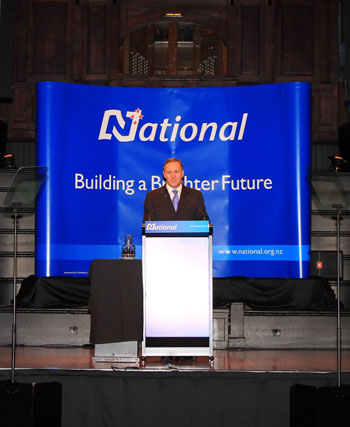Story summary
Formation and rise
The National Party was set up in 1936, when the two main conservative parties, Reform and United, merged. The two parties had campaigned together as the National Political Federation in the 1935 election, but lost to Labour in a landslide.
Sidney Holland led National to win for the first time, in the 1949 election. He believed in individual freedom and responsibility, and was tough on watersiders during the 1951 waterfront labour dispute.
Holland was replaced by Keith Holyoake in 1957. Labour won in 1957, but National then won four elections in a row.
1960s to 1980s
National was in power through the 1960s. It was a decade of rising prosperity for most New Zealanders, but from 1965 there were also protests – for women’s rights and the environment, and against the Vietnam War.
Robert Muldoon became National’s leader in 1974, and prime minister the following year. He was popular at first, but was later in conflict with both liberals and conservatives. His government regulated the economy strongly. When National MP Marilyn Waring decided to vote for Labour’s nuclear-free legislation in 1984, Muldoon called a snap election – which Labour won in a landslide.
1980s to 2020s
National, led by Jim Bolger, won the election in 1990. Bolger’s government continued the economic reforms of the previous Labour government. They cut welfare benefits, and passed laws to make union membership voluntary.
In 1996 MMP (mixed-member proportional representation) was introduced, and National formed a coalition government with the New Zealand First party. In 1997 Bolger was ousted as leader by Jenny Shipley, New Zealand’s first woman prime minister. However, the next three elections resulted in Labour-led governments.
In 2008 John Key led National to victory, forming a government with support from the Māori Party, ACT and UnitedFuture. Bill English succeeded Key as prime minister and party leader in 2016, but National lost power to Labour after the 2017 election and was heavily defeated in 2020.
Party organisation
In the early 1970s National had about 200,000 members, from many different parts of society. However, party membership later declined.
National’s party organisation, which is separate from its parliamentary section, holds an annual conference to elect its governing board, hear from senior MPs and, in closed sessions, discuss policies.
While some Māori leaders have been involved with National, the party has never had broad support among Māori. However, the 2008–17 National-led government was supported by the Māori Party (Te Pāti Māori).





